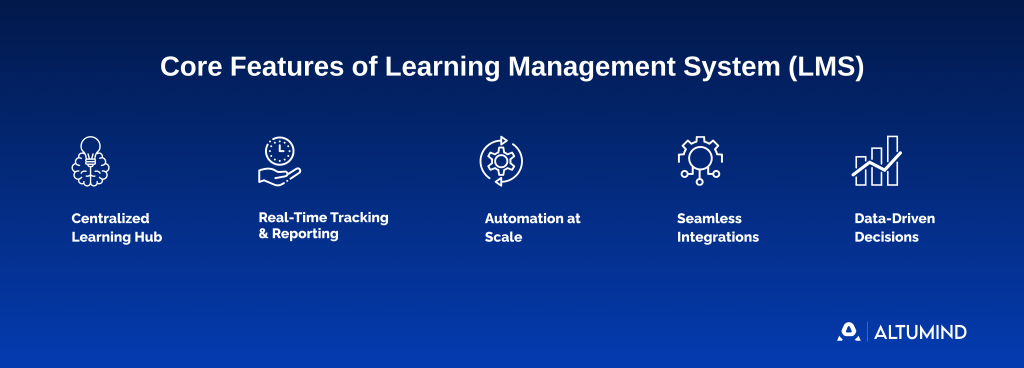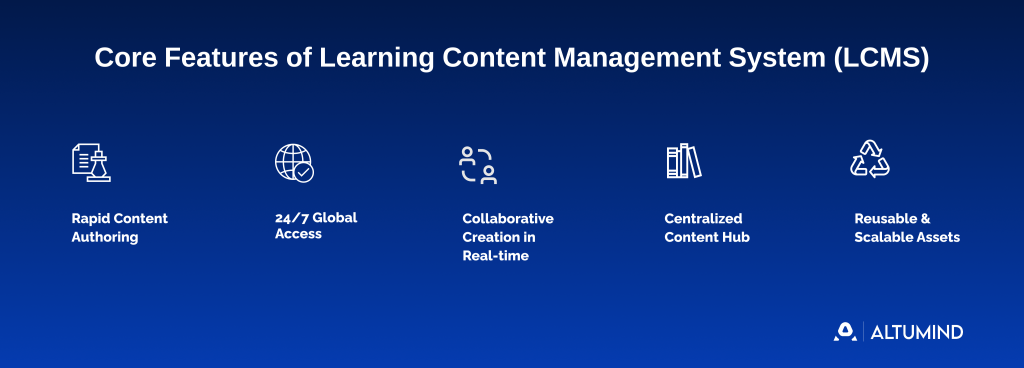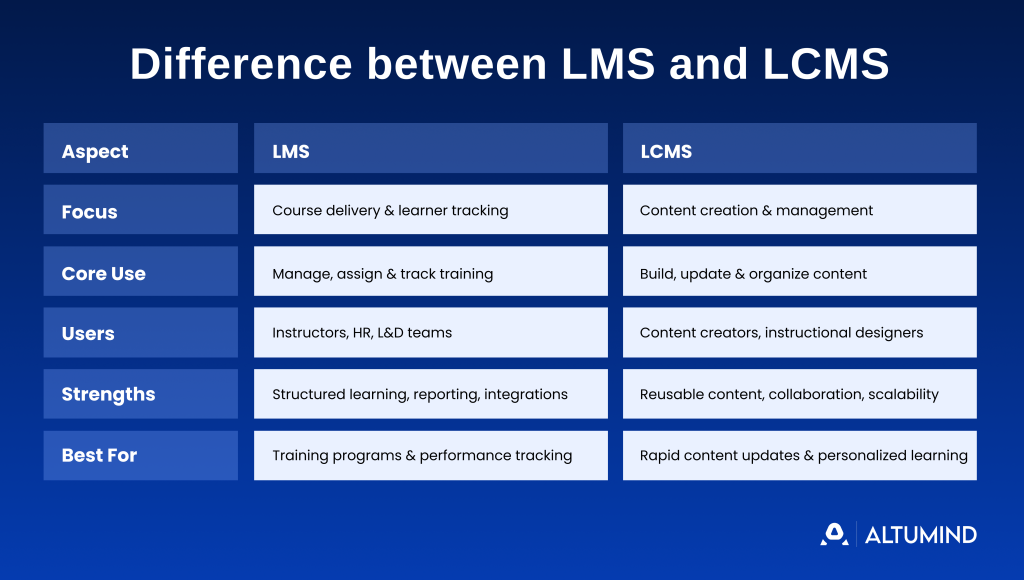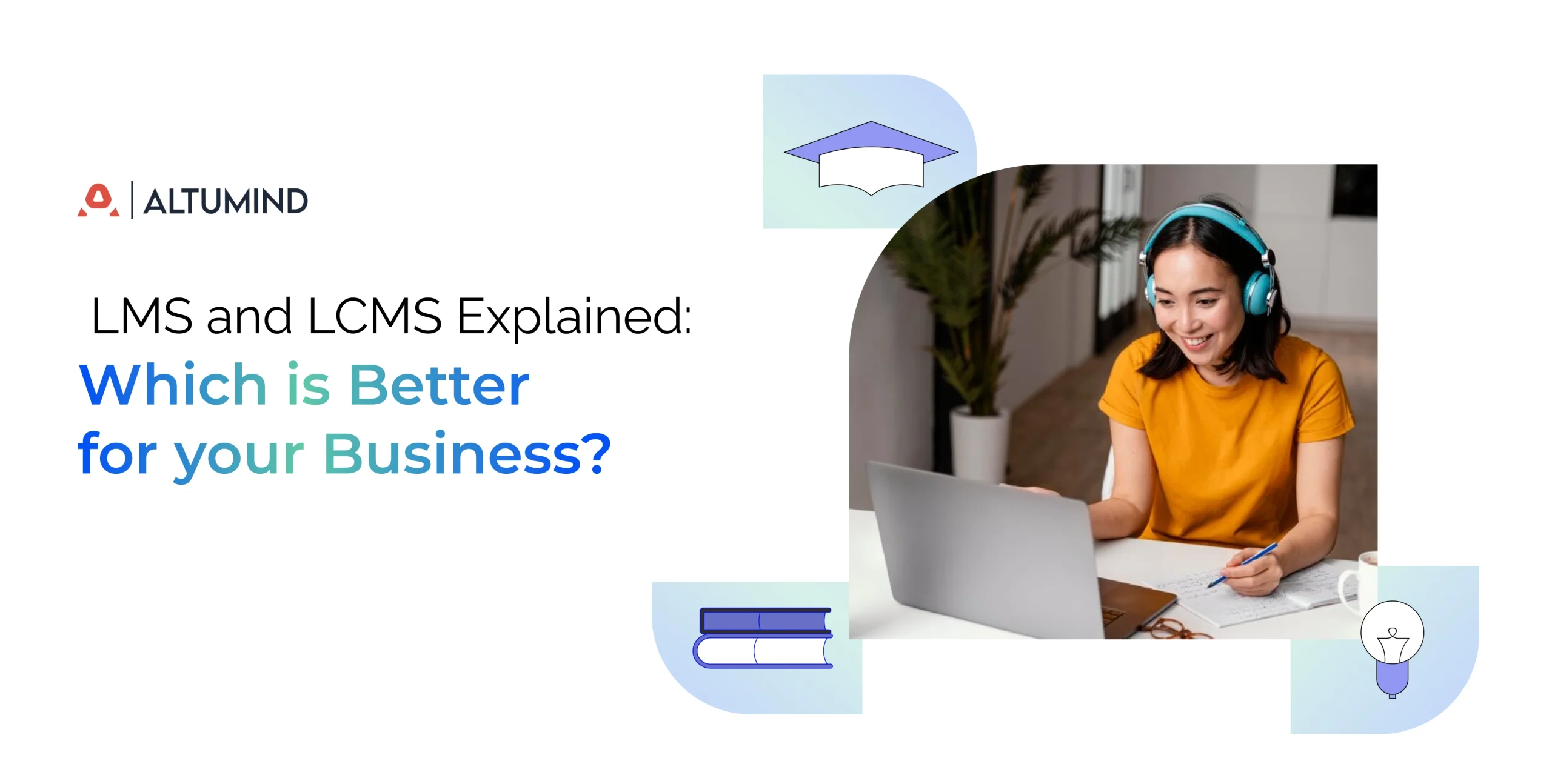In a world where learning never stops, understanding the difference between Learning Management Systems (LMS) and Learning Content Management Systems (LCMS) is critical. This empowers businesses to deliver the best learning outcomes in a seamless, efficient, affordable, and customized manner in line with your business goals while offering top-tier immersive learning experiences.
Both LMS and LCMS play vital roles in delivering engaging, personalized, and scalable learning experiences, but they have certain concrete and subtle differences that set them apart. In today’s blog, we’ll explore these features and benefits and conclude which one belongs in your business space. Let’s get started!
Tenets of any Learning and Training Ecosystem
1. Learning Culture:
From an organizational point of view, teams could initiate an agile learning culture that encourages everything from micro-credentials to certifications. Edtech platforms can persuade users to pick up courses based on their profile details or leverage activity on the site to recommend courses in the same field. Shower incentives, send email reminders, or drop push notifications.
2. Personalized Learning:
Build tailored content aligned with learner personas by adjusting pace, format, and assessments to boost engagement. From PDFs to videos, infographics, and more – the goal is to make learning fun and less intimidating. A framework that can adapt to the team or individual’s preferences will likely be more rewarding.
3. Anytime, anywhere:
Offline learning or workshops can complement online tutorials, seminars, assessments, and demos. Omnichannel learning gives users control over where they wish to learn. Attend pre-recorded or live sessions online, try out the mobile app, or visit an academy and attend the same in person to get a unified learning experience.
4. Simplify the Process:
A learning strategy built around gamification elements could make the journey more interactive and immersive. Byte-sized, easily digestible, and reward-based learning levels can drive more engagement, leading to frequent and longer learning sessions. A less strenuous and more exciting learning path may give more motivation.
5. End-to-end Integrations:
Integrate your LMS with tools like SharePoint and Slack to streamline workflows and reduce platform-hopping. Integrations will ensure seamless connectivity between your LMS and other business applications.
6. Strategic Objectives:
Organizations looking to start or optimize learning outcomes can build a framework that aligns with their immediate and future goals. All upcoming learning and development programs can be an extension of your business needs. It’s simple, develop a syllabus around focus areas and the skills that matter now or may potentially matter in the future.
What is a Learning Management System (LMS)
LMS, or Learning Management System, is a holistic system for administering, planning, delivering, and tracking training and educational programs. This automated learning solution helps organizations and educational institutes make learning more engaging and accessible and helps improve skills, retention, and productivity.
As BCG puts it, “Organizations need a learning ecosystem that facilitates continuous capability building and upskilling in the workplace—equipping people at all levels with future-critical knowledge and skills.” As an all-in-one platform, LMS anticipates and addresses this, making learning more seamless, user-friendly, customizable, and effective for both the faculty and learners.
LMS is a convenient platform where educators and trainers can create, distribute, and manage learning content from a centralized platform. Post-pandemic, the emphasis on remote learning has made LMS all the more vital in Enterprises. Edtech too has embraced LMS for the convenient delivery of complex education.

Core Benefits of Learning Management System (LMS)
- Enhance learning efficiency, accessibility, and engagement
- Drives organizational change by fostering a culture of continuous learning
- Adapt to the rapidly changing business landscape
- Identify skills gaps in the workforce
- Develop skills needed for the future of work – Analytics and AI
- Employees can take ownership of their learning and development
- Improve employee performance and productivity on ad-hoc business goals
- Build an engaging curriculum without compromising on the academic tenets
- Train employees on compliance, data privacy, and cybersecurity
- LMS as a strategic investment can deliver significant ROI
What is a Learning Content Management System (LCMS)
Learning Content Management Systems (LCMS) view learning content as an asset. An LCMS focuses on creating, managing, and scaling multimedia content and making it easily accessible and reusable.
Unlike LMS, delivery isn’t central to LCMS. An LCMS prioritizes content prep and availability and less on deliverability. All content repositories that don’t require instructor-based learning are examples of LCMS.
Authoring and visual tools allow content developers to create content in various formats, such as text, audio, and video. From flowcharts to frameworks, GIFs, and walk-throughs, admins can easily retrieve, track, and reuse content throughout their lifecycle. Ultimately, in LCMS learning the focus remains on building a frictionless UI that facilitates easy creation and management of top-tier content.

Core Benefits of Learning Content Management System (LCMS)
- LCMS learning fosters a culture of continuous learning within organizations
- Make content high-quality, relevant, and engaging for learners
- LCMS learning supports content reusability, repurposing content across divisions
- Improve accuracy, update content, and keep it compliant with regulations
- Can be personalized, you can meet the specific needs of different roles
- LCMS learning Improves learning effectiveness and efficiency
- Reduce costs and improve the ROI of learning programs

LMS vs LCMS - Best Choice
Go for LMS if your primary goal is to manage and deliver training programs and track learner performance. An LMS provides course management, learner profile creation, content delivery, assessments, and reporting. However, pick LCMS, if you wish to create and manage high-quality learning content with collaboration and frequent updates. LCMS offers robust authoring tools, collaborative content creation, version control, and detailed content tracking.
Universities and Schools use LMS. LMS helps deliver online courses, track student progress, and manage assignments. Governments, non-profits, and companies in finance, healthcare, manufacturing, etc. use LMS to manage employee development, as part of the corporate training. Edtech companies, creating and selling educational online courses, Universities, and Corporations in almost all major industries lean towards LMS.
In the end, it’s neither LMS nor LCMS. It never was LMS vs LCMS. Organizations typically leverage both, that’s right they opt for LMS and LCMS. Effective content prep, delivery, and learning require firms to use both to create the best learning experiences. Users need access to well-defined hierarchical content structures (LCMS) and instructor-driven learning (LCMS) to ingrain meaningful information. So, maybe you’d need both – LMS and LCMS.
A comprehensive training ecosystem embeds both LMS and LCMS. An LMS handles the administrative and delivery aspects, helping to structure, track, and manage information distribution across different regions or departments. Whereas LCMS helps focus on developing materials, repurposing content, and improving consistency (Single Source of Truth).
Wrapping Up - LMS vs LCMS
The focus is shifting towards more engaging and personalized learning experiences. Both LMS and LCMS systems can connect people to personalized learning content and experiences from several sources in different formats, forming a critical part of the digital academic space and enabling users to access learning resources anytime, anywhere. Setting this up allows companies to harness the power of technology to deliver the best learning to build a future-ready workforce.
Both LMS and LCMS have their pros and cons and going ahead, organizations will need a robust learning ecosystem of both LMS and LCMS to create a captivating and continuous learning and upskilling journey, making it easier to attain future critical knowledge, skills, and behaviors. Students and workers should be able to leverage cutting-edge apps, AR, VR, and other emerging tech for an immersive learning space.
Ready to build your own future-ready learning ecosystem? Altumind specializes in designing AI-powered LMS and LCMS platforms tailored to your organizational goals. Let’s co-create a smarter, scalable learning experience.


